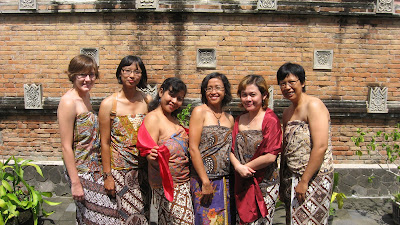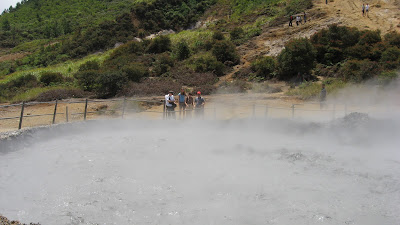Hello Friends and Family,just decided to give you a brief update on my life for the past few weeks. As you know I have been temporarily relocated out of Yogyakarta and the US Embassy will not allow me to return until the Indonesian Government lifts the "Red Alert" status on Mt Merapi. So no worries, they take good care of me over here and won't let me stay anywhere even slightly dangerous. With that, I am most lucky to have been placed with another ETA in Bandung, Mary, for the time being. I have been helping Mary teach her classes at a military boarding school here called Krida Nusantara. It has been an amazing experience so far, the military boarding school has a very different feel from my vocational high school in Jogja. Krida Nusantara is located in the Eastern part of Bandung and has its own complex, like a little college campus up on the side of the mountain overlooking the valley where the city of Bandung lies. The students and teachers all live, work, and go to school on campus. The campus is clean, green, and the fresh air and view from our guesthouse is a rejuvenating way to start each day. The atmosphere is very conducive to enjoying the outdoors, and Mary and I have been running and exercising outside daily which does wonders for one's physical and mental health. The students here are very friendly and well-disciplined, and they are extremely eager to learn English which makes working with them very easy and also rewarding. I certainly miss all of the teachers and students at SMK 6 in Jogja, however, and I will be happy to return and also relieved when Mt Merapi is no longer so active; I worry about the safety of my friends and everyone at SMK 6 in Jogja.
So, a few random plans as of lately.... I will be visiting Lombok, Bali and the Gili islands in December as the schools will be testing for a week, and then will be on Christmas vacation for several weeks after that. Mary and I are also planning a trip to northern Sulawesi to go snorkeling and enjoy the beaches around Gorontalo, Manado and the Togean Islands. Sometimes it is hard to be completely present and just think, "I am really here, I am really helping these wonderful students learn English, and I am really traveling to these amazing places, I am really here in Indonesia." I try to center myself daily and do this, and it is still incredibly amazing and somewhat hard to grasp all at the same time. This week in class Mary and I are doing a lesson about Thanksgiving. We talk about how Thanksgiving is not a religious holiday and how anyone can celebrate it and how it is just meant to be a time to hang out with your family and express what you are thankful for in your life. We play a youtube video of the Macy's Thanksgiving Day Parade which the students think is especially awesome with all the the big floats and marching bands. Then we do the "Hand Turkey" activity, you know, when you were in elementary school and you traced your hands and colored them to look like turkeys? The students enjoy getting creative with their turkeys and of course we have them write five things they are thankful for along with their drawings. Its nice to walk around the class and read them and I think it is a good life lesson for everyone, not just the students but for Mary and I as well. It focuses our minds on what we are so grateful for and lucky to have in this life. Sometimes it is far too easy to focus on the negative things and everything little thing that goes wrong in everyday life; small good deeds and successes often slip by, unnoticed. The students make me smile with the things they come up with and of course it makes me reflect on my own life and the many things in it I have to be thankful for. Also in celebration of Thanksgiving, Mary and Yours Truly will be cooking a traditional Thanksgiving dinner for all the of teachers here at Krida. So far we have cranberry sauce from a can, potatoes but no whisk or mashing device, two whole turkeys and stuffing but no adequate pan to cook either, no turkey baster, and not to mention absolutely no prior cooking experience of any kind. Just the sheer determination of two women who want to stoke the fire of cross-cultural understanding via the language of food.
On that note, I have no Hand Turkey to show you, but I will leave you with my own personal list of five things in my life that I am very thankful for:
My Parents- Once upon a time DVG was approached by a petite, young blonde with a fiery attitude in a dimly lit bar just outside of Oscoda, MI. And the rest of this romantic story, ladies and gentlemen, is history- a history I am particularly thankful for. I couldn't ask for a better set of parents. I have been able to excel academically and personally through all of their support and confidence in me. They have full faith in me and all my abilities as an independent young woman and I hope they know that all that I am is a direct product of their love, wisdom, and moral attitudes that they have instilled in me throughout my existence.
My Family and Friends- All of my family and the friends that I have made over the years have proved to be an incredible source of strength and support, especially in times such as these when I find myself so far from home. I can't thank them enough for all the good times they have shared with me, and the joy they continue to put into my life with even the smallest comments and messages they send to me. The love and positive energy you all send my way knows no distance and no barriers.
Zach- This young man has successfully been turning my world upside down for about two years now, and I wouldn't have it any other way. He makes me think of things I would have never thought of before, he makes me view things from a million different angles and thus expands my horizons infinitely everyday. He supports me in everything I do and has my back on absolutely anything. He exhibits the most genuine qualities one could ever hope to find in a human being and restores my faith in life and humanity on a daily basis. It has been an honor and a privilege to share my time with such an individual.
My Extended Family- I knew upon meeting Zach that such a creature had to have come from some long line of immaculate selections from the gene pool and revolutionary parenting skills. I very much consider Zach's family to be my own family and certainly miss their presence everyday as I miss that of my own. I am so incredibly happy that they have shared their lives with me these past few years and they have influenced me in ways they will most likely never fully comprehend. Their kindness, open-mindedness and humble brilliance has been a very strong pillar of support and guidance for me in times of need.
This opportunity- I am very grateful for the opportunity to be here in Indonesia for the better part of a year. This experience fully immerses me in a culture very different from my own and makes me question things and analyze things I would not have before. Throughout the process of teaching here I have had the pleasure of meeting hundreds of students that exhibit more drive, more personality, and more heart than many people will encounter in an entire lifetime. This opportunity not only allows me to learn about other cultures and traditions, but shows me the true colors of my own person and highlights the shades and hues of this strange palate that paint the colors of the human race as a whole.





















































